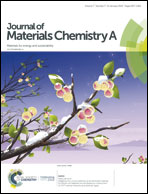Ultrahigh energy density of a N, O codoped carbon nanosphere based all-solid-state symmetric supercapacitor†
Abstract
Quinones are attractive redox-active starting materials due to their excellent electron transfer kinetics and outstanding redox reversibility, while amines featuring high electron-pair donicity reinforce the redox behavior of quinones and simultaneously introduce redox groups themselves. Herein, a novel quinone-amine route is designed to fabricate N, O codoped porous carbon nanospheres (PCNs) by direct carbonization–activation of a quinone-amine polymer which serves as an “all-in-one” precursor for the carbon source and self-dopant. The synthesis features simplicity, high efficiency and scale-up potential, based on the polymerization of p-benzoquinone and 3,3′-diaminobenzidine in ethanol under mild conditions, without any template, complicated technique or tedious procedure. PCNs integrate the superiorities of uniform spherical geometry, superior pore structure, and ultrahigh surface area and N/O content. A typical PCN electrode exhibits a high capacitance (376 F g−1 at 0.5 A g−1 in a three-electrode system) in KOH electrolyte. The assembled supercapacitor based on the PCN electrode and KOH electrolyte delivers a capacitance of 72.5 F g−1 and an energy output of 6.5 W h kg−1. More importantly, a constructed symmetric supercapacitor using an ionic liquid gel electrolyte gives an ultrahigh energy density up to 65.8 W h kg−1, along with superb cycling stability. This study presents a more convenient and competitive route to design functionalized carbons for highly efficient energy storage.

- This article is part of the themed collection: 2019 Journal of Materials Chemistry A Most Popular Articles


 Please wait while we load your content...
Please wait while we load your content...